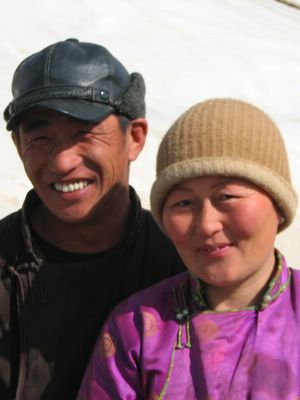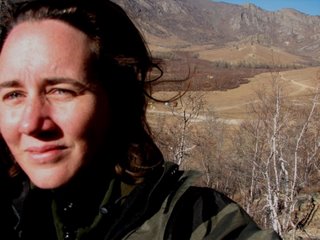
Sara and Dunbar at their home near Kharkhorin

A special place that I’ve been to three times now is Kharkhorin or it is otherwise known as Karakorum. It was the ancient capital of Mongolia. It is now just a pokey little town with a very big temple site on the outskirts. The temple complex is called ‘Erdene Zuu’. It was once the site of a grand temple, but has been bulldozed and rebuilt many times. It was seriously bulldozed by the soviets sometime in the 20th century but is now an interesting place to visit to see the remains including old granite stone tablets engraved with Islamic script that was once a marker of the Islamic part of the city. There is an active Buddhist temple on site, and it is quite a spectacle to be in there at worship time. All the monks are young boys and there is no sense of order as they are prodding and poking each other, giggling and chatting and missing their cue to hit the gong during the chanting of mantras that they are meant to be focused on. In such a reverent place it is quite amusing to witness their boyish antics.
On the most recent trip to Kharkhorin we visited Dunbaa and Sara who are a herding family that I have stayed with before. They have a new beautiful baby son, and he was born on ‘mens day’. (yes they have a national men’s day and a women’s day. Women’s day is on international women’s day and is a public holiday! No such luck for the men). They have an income of approx $3000 per year. About a third of their income comes from selling raw cashmere. One Mongolian goat produces about 300-400 grams of cashmere and raw cashmere sells for about $30 a kilo. They look after the goats all year round – but they just feed on open pasture near to the families camp and then in early spring they comb the goats to get the cashmere. They had already harvested and sold their cashmere by the time we got there, but mid spring is when all the babies are born so they divide the stock between the two families. One family looks after the kids and mothers and the other family looks after the non-parent goats. They also have sheep, horses and a camel. The camel is primarily used for when they move camp (a couple of times a year). A third of their income also comes from tourism. Our friend Gans is a tour operator (a very entrepreneurial young man) and he uses them as tourist accommodation. Throughout the summer they have usually 2 or 3 guests a week! Their camp is a couple of hours from Kharkhorin which is one of the most visited destinations on the tourist itinerary. In the spring and summer they also live right next to a strip of desert that Gans calls ‘fake gobi’ because many tourists on short stays in Mongolia come and stay there (in various tourist ger camps) as a little gobi experience, as the real gobi is much further away. The final third of their income is from selling livestock and meat from their existing stock. Their level of income makes them quite wealthy in terms of most herders. Many are only earning $500-1000 a year.
Dunbaa and Sara have three children now and Sara says that she will not be having anymore, but she everyone else says that she probably will. She comes from a family of 9 children which is not uncommon for rural families. In the communist times women used to get medals for the number of children they had. Sara was well educated and smart and sometimes thinks about what life in UB would be like, but it seems to me that life for her in UB would probably not be very nice. She would probably be living in a ger suburb and earning a pittance and having to deal with contaminated water and air pollution and all the social problems (such as alcoholism) that exist in the ger suburbs. And she would need to be relying on her family for financial assistance. I think she has a very nice life myself!
Sara and Gans taught us how to make horshoor. They are fried dumplings that look a little bit similar to pasties. Usually horshoor is made with slightly off meat, but we actually made fish horshoor which was incredibly delicious. It was not easy work – it took me about 2 minutes to put one horshoor together and in that time Sara made about 10. I guess she’s had more practice than me. They live an amazing life. I love staying there, but I suppose there is the unromantic side like not having running water or a toilet or much of any modern conveniences really. Mind you they have a solar panel which gives them some electricity and a satellite dish for the TV. Not too bad. The women definitely have the raw end of the deal, having to clean and cook and run around – while the men get to go riding around the steppe and come home to a hot cooked meal.
The beautiful life of the mongolian nomads is easy to appreciate.


2 comments:
Thanks for the great description and details. I just keep thinking of the movie about the weeping camel and so your details help round out that picture!
the weeping camel is a brilliant real life illustration of herding life in mongolia. There is a new film by the same people called 'the cave of the yellow dog' it is also an excellent movie in a similar vein, that gives another good illustration of everyday life for herders but in a different part of the country (not in the GObi, but on the lush green steppe).i highly recommend it!
I was so thrilled to find a copy of the weeping camel DVD in the video shop in Katherine before i left. I actually let out a loud 'who-hoo!' iun the video shop (i was very surprised to find it there) and attracted a few stares. it was my fisrt time hearing the mongolian language. it was very daunting and i thought i would never be able to understand a language that sounded so completely different to anything i'd ever heard before. funny to think that now i can understand a lot (not brillantly mind you, i've decided i'm a bit retarded when it comes to learning languages) and i can speak a bit too. strange...
Post a Comment